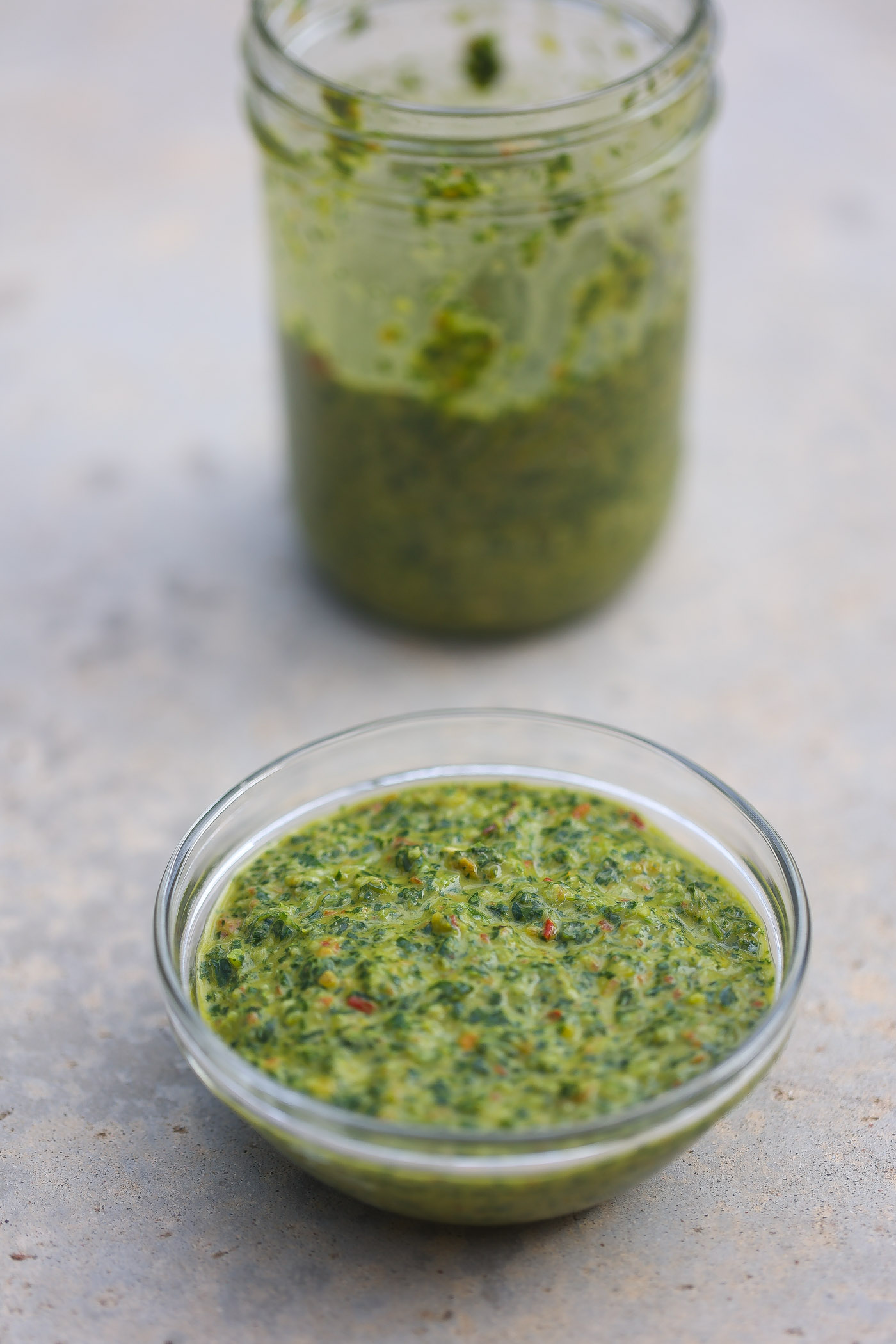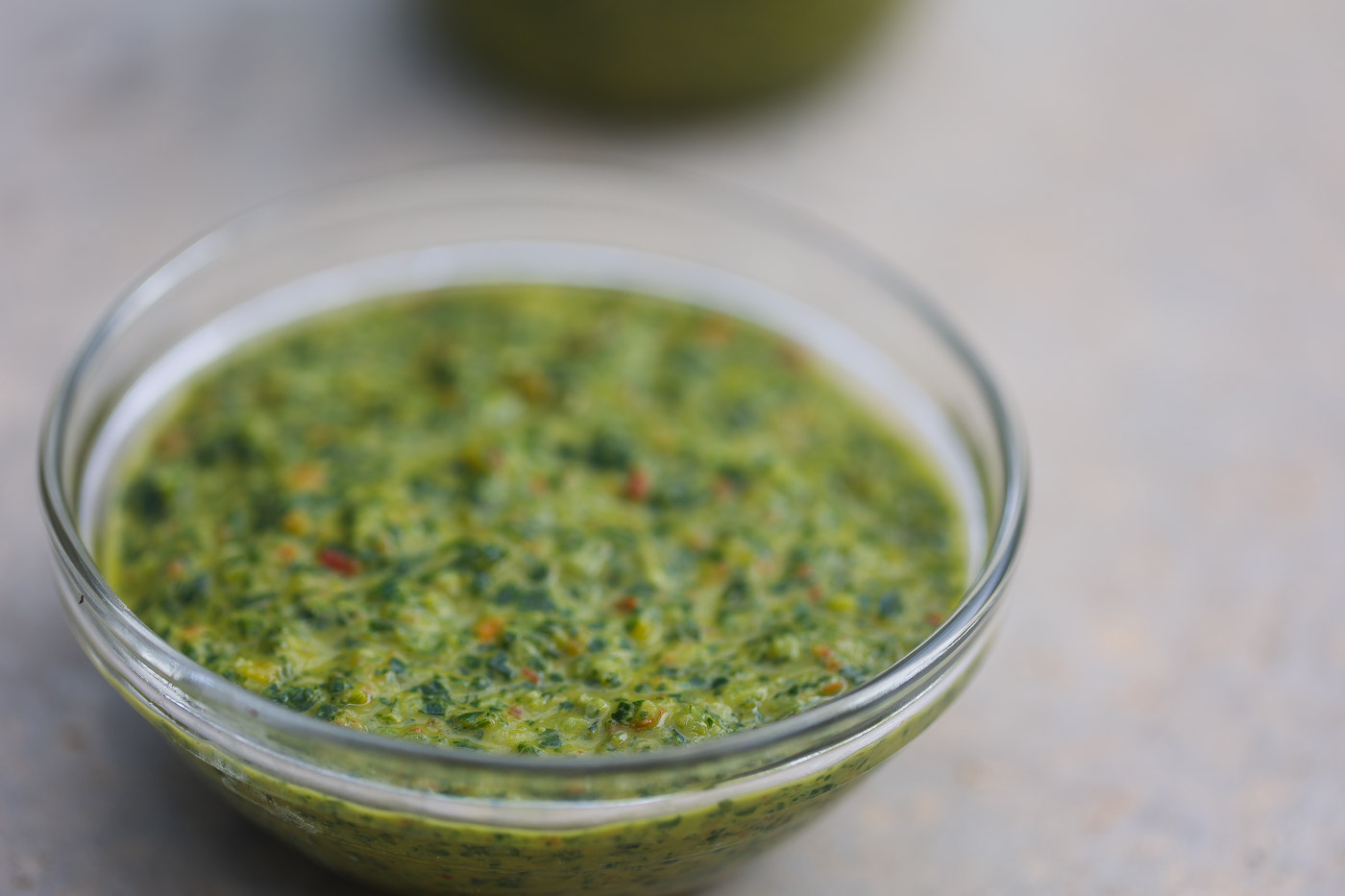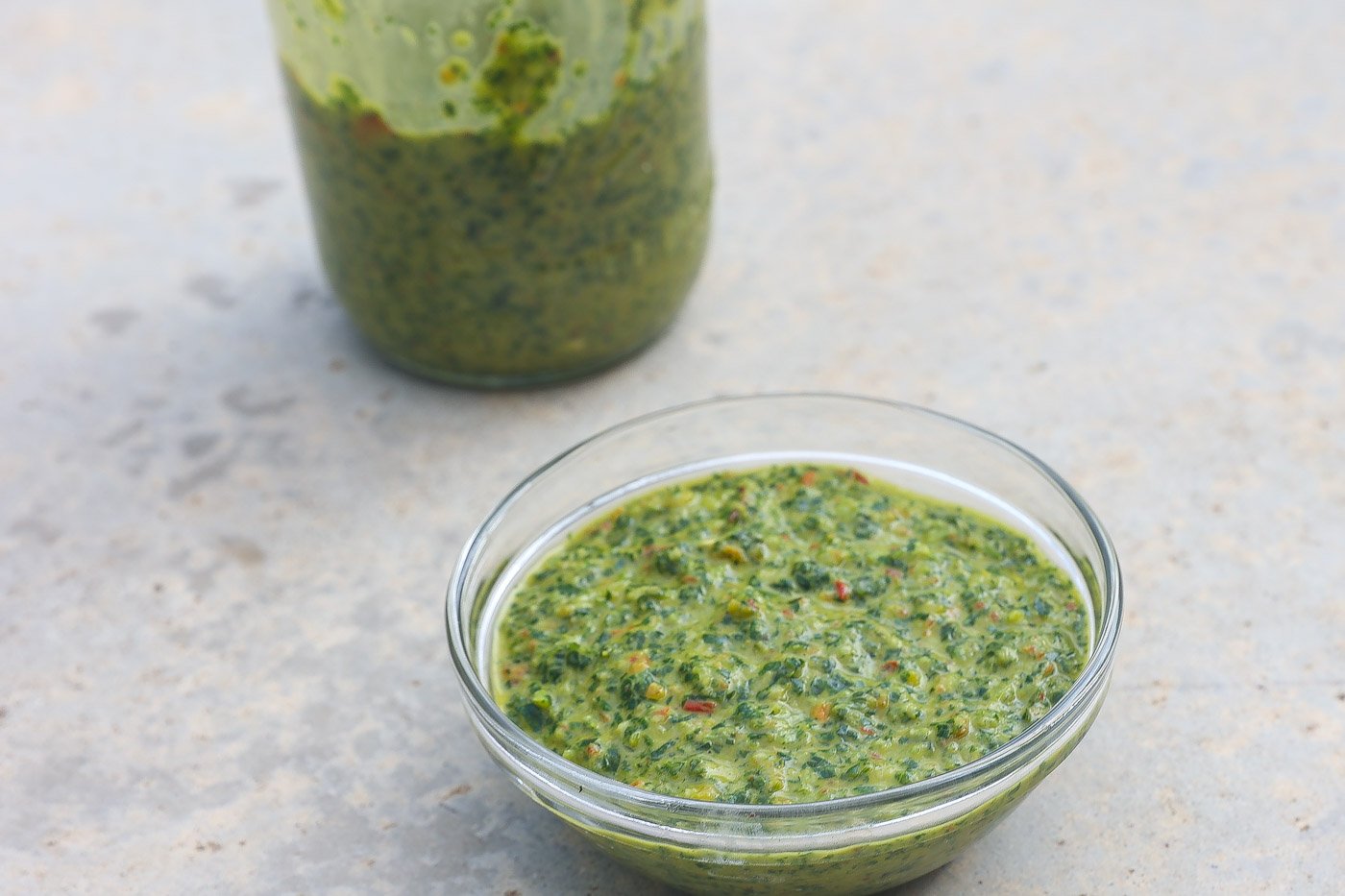This post may contain affiliate links via Amazon's affiliate advertising program. See privacy policy
It may not be familiar to some, but Caribbean green seasoning is one of the most essential ingredients in Caribbean cooking. Bursting with flavour and zest, this concoction of herbs, spices, onions and peppers will add a unique twist to your dishes!
From marinades and sauces to salads and sides, greens seasoning is a Caribbean staple - this homemade ingredient can take your meals from boring to brilliant in an instant. Meal prep for any Caribbean recipes is likely going to involve Trini green seasoning.
What is green seasoning
Green seasoning is a blend of herbs and spices that is commonly used in cuisine of several Caribbean islands, particularly in Trinidad and Tobago, Barbados and Jamaica. It is a paste or marinade made of blended or finely chopped fresh herbs and spices such as cilantro, chadon beni, thyme, garlic, onions, scotch bonnet pepper, and parsley.
It is used as a marinade for meats, seafood, and vegetables or as a base for soups and stews. The ingredients can vary depending on the recipe and regional preferences. It is also known for its strong flavorful and aromatic properties.

Beats and Eats (music to pair with Green Seasoning)
The track "Too Good" by Amaal says it all. Green seasoning on it's own is so good, but served as part of a recipe it is just too good in every way. It's definitely an enhancer.
Ingredients Needed For Caribbean Green Seasoning
The ingredients for this green sauce can vary depending on the recipe and regional preferences, but a typical recipe calls for a combination of fresh herbs and peppers including the following ingredients:
- Fresh culantro aka 'chadon beni' (cilantro can be substituted)
- Fresh thyme
- Red bell pepper
- Cubanelle (optional)
- Green onion
- Garlic
- Ginger
- Lime juice
- Scotch bonnet pepper (habanero or other hot pepper is a good alternative)
- Kosher Salt
- Olive oil
Some variations may also include ingredients such as parsley or pimento peppers. The herbs and spices are typically blended or finely chopped together to create a coarse texture or paste-like consistency. Lime or lemon juice can also be added to preserve the green seasoning.
Jamaican vs. Trinidad Green Seasoning
Jamaican and Trinidad green seasoning are similar in that they are both blends of herbs and spices used to marinate meats, seafood, and vegetables. However, there are some subtle differences in the ingredients used and the preparation methods.
Jamaican green seasoning typically includes a combination of thyme, scallions, garlic, and Scotch bonnet pepper. The herbs and spices are often blended together with oil, lime or lemon juice and salt to create a paste-like consistency. This green seasoning is known for its spicy and savory flavor.
Trinidadian green seasoning, on the other hand, is a blend of herbs and spices that typically includes cilantro, chadon beni, thyme, garlic, onions, scotch bonnet pepper, and parsley. It is known for its strong flavorful and aromatic properties. In Trinidad, it's also used as a base for soups and stews.
In both versions, the ingredients can vary depending on the recipe and regional preferences.
In summary, While both Jamaican and Trinidad green seasoning are similar, they have some variations in ingredients and preparation.
How To Make Green Seasoning
- Rinse and dry the herbs and spices thoroughly.
- Roughly chop the cilantro, chadon beni, thyme, parsley, garlic, onions, and scotch bonnet peppers.
- Place all the ingredients in a food processor or blender and pulse until a smooth paste forms.
- Taste the seasoning and add salt if desired.
- Store the green seasoning in a glass jar or container with a tight-fitting lid in the refrigerator for up to a week.
Note: It's important to wear gloves when handling the scotch bonnet peppers, as they can cause severe burning sensations if they come into contact with your skin or eyes.
This recipe is a basic guide and you can adjust the proportion of ingredients to your liking. Feel free to play around with the recipe and add or adjust the ingredients to suit your taste.
Also, you can use other ingredients like ginger and celery to make green seasoning.
Tips for making green seasoning
- Use fresh ingredients: Fresh herbs and spices will give your green seasoning the best flavor and aroma. Make sure to rinse and dry the ingredients thoroughly before using them.
- Adjust the heat: If you prefer a milder seasoning, you can reduce the amount of scotch bonnet peppers (habanero pepper)or substitute them with a milder pepper. If you like it spicier, feel free to add more.
- Experiment with different herbs and spices: The recipe I provided is a basic guide, feel free to add or adjust the ingredients to suit your taste. Some other ingredients that can be added are ginger, celery, and scallions.
- Blend well: Make sure to blend the ingredients well until you have a smooth paste-like consistency. This will ensure that the flavors are well distributed and that the seasoning will stick well to your meats, seafood, and vegetables.
- Store properly: Green seasoning can be stored in an airtight container in the refrigerator for up to a week. You can also store it in the freezer for up to 3 months.
- Use as marinade: Green seasoning is great as a marinade for your favorite meats, seafood, and vegetables. You can marinate your meats, seafood or vegetables in green seasoning for at least 30 minutes before cooking, or even overnight for a more intense flavor.
- Use as a base: Green seasoning is also great as a base for soups and stews. Simply add some of the seasoning to a pot with some oil and sauté for a few minutes before adding your other ingredients.
- Adjust salt: Taste the seasoning before you store it, and add salt if desired. Keep in mind that you can always add more salt, but you can't take it out.
- Store leftover green seasoning for up to 3 months in a mason jar with airtight lids or freeze in ice cube trays

What to use green seasoning with
Green seasoning can be used in a variety of dishes to add flavor and aroma. Here are some popular ways to use green seasoning:
- As a marinade: Green seasoning is great as a marinade for meats, seafood, and vegetables. You can marinate your meats, seafood or vegetables in green seasoning for at least 30 minutes before cooking, or even overnight for a more intense flavor.
- As a base for soups and stews: Green seasoning is also great as a base for soups and stews. Simply add some of the seasoning to a pot with some oil and sauté for a few minutes before adding your other ingredients.
- As a sauce or topping: You can also use green seasoning as a sauce or topping for dishes such as tacos, tamales, and tostadas.
- As a condiment: Green seasoning can also be used as a condiment, it can be spooned over rice and beans, sandwiches, and grilled meats, poultry and fish.
- As a seasoning: Green seasoning can be used as a seasoning for a variety of dishes, simply add it to your dish for a boost of flavor.
- As a marinade for meat: Green seasoning is a great marinade for chicken, fish, shrimp, pork, and beef. It adds a lot of flavor and helps to tenderize the meats.
- As a seasoning for vegetables: Green seasoning is also great as a seasoning for vegetables. Simply toss your vegetables in green seasoning before roasting or grilling them.
- As a dip: You can also use green seasoning as a dip, it can be mixed with sour cream or yogurt to make a dip for vegetables, crackers, or chips.
Green seasoning is a versatile condiment that can be used in a variety of dishes to add flavor and aroma, feel free to experiment and use it in different ways to suit your taste.
Frequently asked questions (FAQs) about Green Seasoning
Is green seasoning the same as sofrito?
Green seasoning and sofrito are both blends of herbs and spices used as a base for cooking, but there are some differences between the two.
Green seasoning is commonly found in Caribbean cuisine, particularly in Trinidad and Tobago, Barbados, and Jamaica. It is a paste or marinade made of blended or finely chopped fresh herbs and spices such as cilantro, chadon beni, thyme, garlic, onions, scotch bonnet pepper, and parsley. It is used as a marinade for meats, seafood, and vegetables or as a base for soups and stews. It is known for its strong flavorful and aromatic properties.
Sofrito, on the other hand, is a blend of herbs and spices that is commonly used in Spanish and Latin American cuisine. It is typically made with a combination of onions, garlic, and tomatoes, along with other ingredients such as cilantro, culantro, bell peppers, and ají dulce (sweet peppers). Sofrito is used as a base for many dishes, such as soups, stews, and rice dishes. It is used to provide a flavorful and aromatic foundation for the dish.
In summary, Green seasoning and sofrito are both blends of herbs and spices used as a base for cooking, but Green seasoning is more specific to Caribbean cuisine and Sofrito is more specific to Spanish and Latin American cuisine. While both are similar in their purpose, their ingredients and preparation methods can vary.
What are the ingredients of green seasoning?
Green seasoning typically includes a combination of fresh cilantro, chadon beni, thyme, garlic, onions, scotch bonnet pepper and parsley. These ingredients are usually blended together to make a paste-like consistency.
How long does green seasoning last?
Green seasoning can be stored in an airtight container in the refrigerator for up to a week. You can also store it in the freezer for up to 3 months.
Can I make green seasoning without scotch bonnet pepper?
Yes, you can make green seasoning without scotch bonnet pepper. Simply omit it from the recipe or substitute it with a milder pepper if you prefer a milder seasoning.
Can I use dried herbs instead of fresh herbs?
While fresh herbs will give your green seasoning the best flavor and aroma, you can use dried herbs if that's what you have on hand. Keep in mind that the flavor may be less intense and you may need to use more to achieve the same flavor.
Is green seasoning gluten-free?
Green seasoning is gluten-free as it is made with herbs and spices, and no gluten-containing ingredients.
Is Caribbean green seasoning vegan?
Yes, green seasoning is vegan as it is made with herbs, spices, and no animal products.
Can I use green seasoning in dishes other than Caribbean?
Yes, green seasoning can be used in a variety of dishes and cuisines, not just Caribbean. Feel free to experiment and use it in different ways to suit your taste.
Special Equipment Needed
A food processor or blender will be needed to chop/blend the seasoning mix to desired consistency.
Make This Recipe
In conclusion, this Caribbean green seasoning recipe is full of flavor and can be used to transform any meal. You can play around with it, adjust the ingredients until it meets your own personal tastes, and discover an amazing way to add a burst of flavors to everyday dishes. Be sure to use fresh herbs if you can for that delicious kick.
This flavorful blast from nature is sure to leave any dish tasting better than before! So what are you waiting for? Put together your very own homemade green seasoning recipe and make something special today. Don’t forget to share it with friends and family too because they will thank you later. Have fun and make this recipe today!
If you make this great recipe or any other from the site, please come back and leave me a comment below with your feedback. Definitely take a photo of the dish and be sure to tag #foodfidelity so that I can see them.
You can also keep up with my food exploits as well as original recipes! You can find me on Instagram, Facebook, Twitter, and Pinterest. If you like any of the music you find on the site, visit me at Spotify to find curated monthly playlists.
Lastly, go to my YouTube channel and subscribe to be notified when new weekly videos are uploaded.
Ingredients
- 1 cup Fresh culantro cilantro can be substituted
- ½ cup Fresh parsley
- 5-6 sprigs Fresh thyme
- ½ medium Red bell pepper roughly chopped
- 1 Cubanelle pepper roughly chopped
- 6 Green onion scallions chopped
- 4 Garlic cloves minced
- 1 teaspoon Ginger grated
- 1 Lime juiced
- 1 Scotch bonnet pepper de-seeded habanero or other hot pepper is a good alternate
- 1 teaspoon Kosher Salt
- 1 tablespoon Olive oil
Instructions
- Rinse and dry the herbs and spices thoroughly.
- Place all the ingredients in a food processor or blender and pulse until a smooth paste forms.
- Taste the seasoning and add salt if desired.
- Store the green seasoning in a glass jar or container with a tight-fitting lid in the refrigerator for up to a week.
Notes
- Use fresh ingredients: Fresh herbs and spices will give your green seasoning the best flavor and aroma. Make sure to rinse and dry the ingredients thoroughly before using them.
- Adjust the heat: If you prefer a milder seasoning, you can reduce the amount of scotch bonnet peppers (habanero pepper)or substitute them with a milder pepper. If you like it spicier, feel free to add more.
- Experiment with different herbs and spices: The recipe I provided is a basic guide, feel free to add or adjust the ingredients to suit your taste. Some other ingredients that can be added are ginger, celery, and scallions.
- Blend well: Make sure to blend the ingredients well until you have a smooth paste-like consistency. This will ensure that the flavors are well distributed and that the seasoning will stick well to your meats, seafood, and vegetables.
- Store properly: Green seasoning can be stored in an airtight container in the refrigerator for up to a week. You can also store it in the freezer for up to 3 months.
- Use as marinade: Green seasoning is great as a marinade for your favorite meats, seafood, and vegetables. You can marinate your meats, seafood or vegetables in green seasoning for at least 30 minutes before cooking, or even overnight for a more intense flavor.
- Use as a base: Green seasoning is also great as a base for soups and stews. Simply add some of the seasoning to a pot with some oil and sauté for a few minutes before adding your other ingredients.
- Adjust salt: Taste the seasoning before you store it, and add salt if desired. Keep in mind that you can always add more salt, but you can't take it out.
- Store leftover green seasoning for up to 3 months in a mason jar with airtight lids or freeze in ice cube trays

